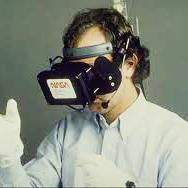Life science today involves computational analysis of a large amount and variety of data, such as volumetric data acquired by state-of-the-art microscopes, or mesh data from analysis of such data or simulations. Visualization is often the first step in making sense of data, and a crucial part of building and debugging analysis pipelines. It is therefore important that visualizations can be quickly prototyped, as well as developed or embedded into full applications. In order to better judge spatiotemporal relationships, immersive hardware, such as Virtual or Augmented Reality (VR/AR) headsets and associated controllers are becoming invaluable tools. In this work we introduce scenery, a flexible VR/AR visualization framework for the Java VM that can handle mesh and large volumetric data, containing multiple views, timepoints, and color channels. scenery is free and open-source software, works on all major platforms, and uses the Vulkan or OpenGL rendering APIs. We introduce scenery's main features and example applications, such as its use in VR for microscopy, in the biomedical image analysis software Fiji, or for visualizing agent-based simulations.
翻译:今天的生命科学涉及对大量和多种数据进行计算分析,如通过最新显微镜获得的体积数据,或从分析这些数据或模拟中获得的网状数据。可视化往往是使数据具有意义的第一步,也是建设和调试分析管道的关键部分。因此,视觉化必须能够迅速进行原型,以及开发或嵌入到完整的应用中。为了更好地判断波形时际关系,隐蔽的硬件,例如虚拟或放大现实(VR/AR)头目和相关控制器等,正在成为宝贵的工具。在这项工作中,我们引入了景象学,一个灵活的VR/AR可视化框架,用于爪哇VM处理网状和大体积数据,包含多个视图、时间点和颜色通道。风景是免费的开源软件,在所有主要平台上进行工作,并使用Vulkan或OpenGL生成APIs。我们引入了场景的主要特征和应用程序,例如在VR用于显像学、图像分析斐济的图像分析软件中或VR用于图像代理器。



